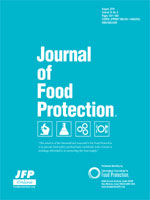Ver ítem
- xmlui.general.dspace_homeCentros e Institutos de InvestigaciónCIA. Centro de Investigaciones de AgroindustriaInstituto de Tecnología de AlimentosArtículos científicosxmlui.ArtifactBrowser.ItemViewer.trail
- Inicio
- Centros e Institutos de Investigación
- CIA. Centro de Investigaciones de Agroindustria
- Instituto de Tecnología de Alimentos
- Artículos científicos
- Ver ítem
Genotypic Characterization of Non-O157 Shiga Toxin–Producing Escherichia coli in Beef Abattoirs of Argentina
Resumen
The non-O157 Shiga toxin–producing Escherichia coli (STEC) contamination in carcasses and feces of 811 bovines in nine beef abattoirs from Argentina was analyzed during a period of 17 months. The feces of 181 (22.3%) bovines were positive for non-O157 STEC, while 73 (9.0%) of the carcasses showed non-O157 STEC contamination. Non-O157 STEC strains isolated from feces (227) and carcasses (80) were characterized. The main serotypes identified were O178:H19,
[ver mas...]
The non-O157 Shiga toxin–producing Escherichia coli (STEC) contamination in carcasses and feces of 811 bovines in nine beef abattoirs from Argentina was analyzed during a period of 17 months. The feces of 181 (22.3%) bovines were positive for non-O157 STEC, while 73 (9.0%) of the carcasses showed non-O157 STEC contamination. Non-O157 STEC strains isolated from feces (227) and carcasses (80) were characterized. The main serotypes identified were O178:H19, O8:H19, O130:H11, and O113:H21, all of which have produced sporadic cases of hemolytic-uremic syndrome in Argentina and worldwide. Twenty-two (7.2%) strains carried a fully virulent stx/eae/ehxA genotype. Among them, strains of serotypes O103:[H2], O145:NM, and O111:NM represented 4.8% of the isolates. XbaI pulsed-field gel electrophoresis pattern analysis showed 234 different patterns, with 76 strains grouped in 30 clusters. Nine of the clusters grouped strains isolated from feces and from carcasses of the same or different bovines in a lot, while three clusters were comprised of strains distributed in more than one abattoir. Patterns AREXSX01.0157, AREXBX01.0015, and AREXPX01.0013 were identified as 100% compatible with the patterns of one strain isolated from a hemolytic-uremic syndrome case and two strains previously isolated from beef medallions, included in the Argentine PulseNet Database. In this survey, 4.8% (39 of 811) of the bovine carcasses appeared to be contaminated with nonO157 STEC strains potentially capable of producing sporadic human disease, and a lower proportion (0.25%) with strains able to produce outbreaks of severe disease.
[Cerrar]

Autor
Masana, Marcelo Oscar;
D’Astek, Beatriz A.;
Palladino, Pablo Martin;
Galli, Lucia;
Del Castillo, Lourdes;
Carbonari, Claudia Carolina;
Leotta, Gerardo A.;
Vilacoba, E.;
Irino, K.;
Rivas, Marta;
Fuente
Journal of Food Protection 74 (12 ): 2008–2017 (2011)
Fecha
2011-12
ISSN
0362-028X
1944-9097
1944-9097
Formato
pdf
Tipo de documento
artículo
Palabras Claves
Derechos de acceso
Abierto
 Excepto donde se diga explicitamente, este item se publica bajo la siguiente descripción: Creative Commons Attribution-NonCommercial-ShareAlike 2.5 Unported (CC BY-NC-SA 2.5)
Excepto donde se diga explicitamente, este item se publica bajo la siguiente descripción: Creative Commons Attribution-NonCommercial-ShareAlike 2.5 Unported (CC BY-NC-SA 2.5)


